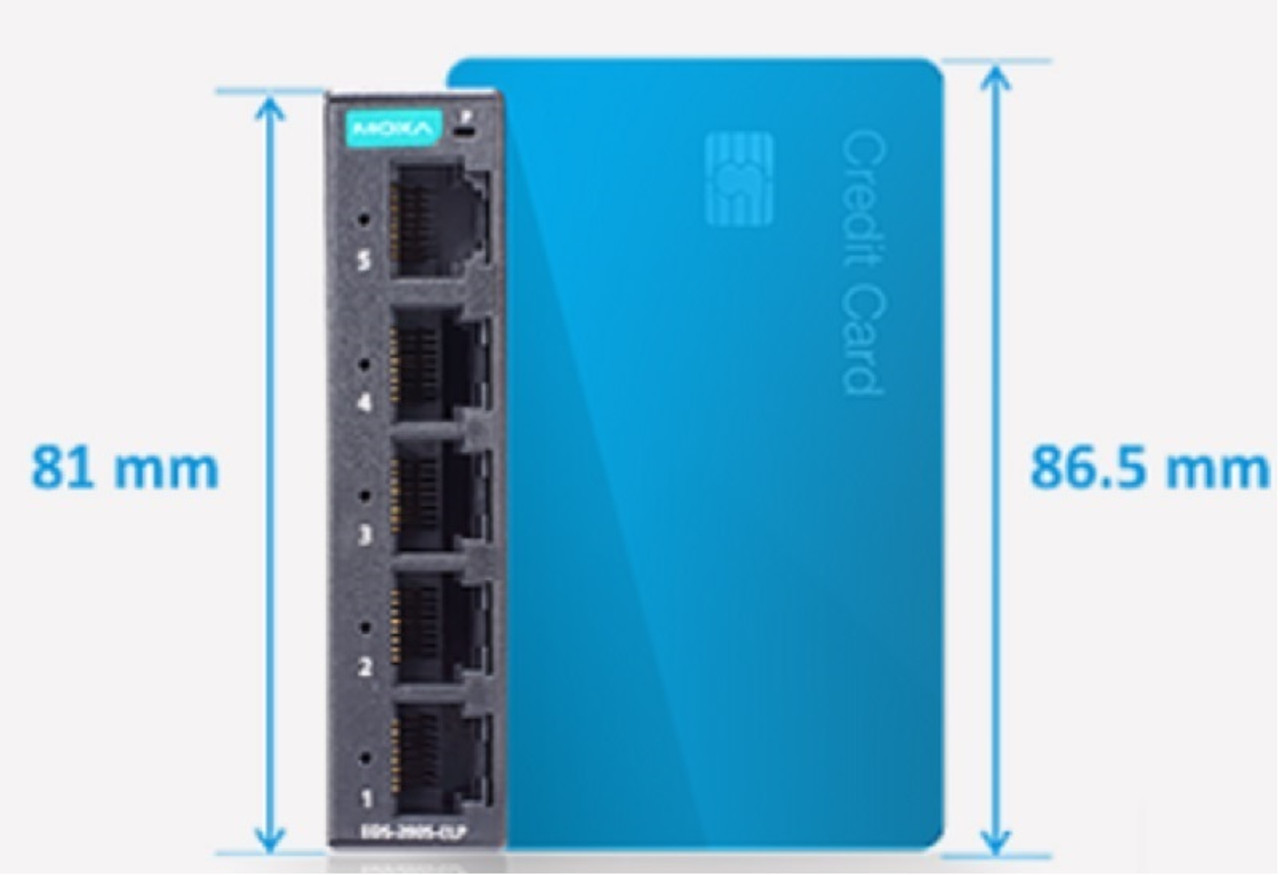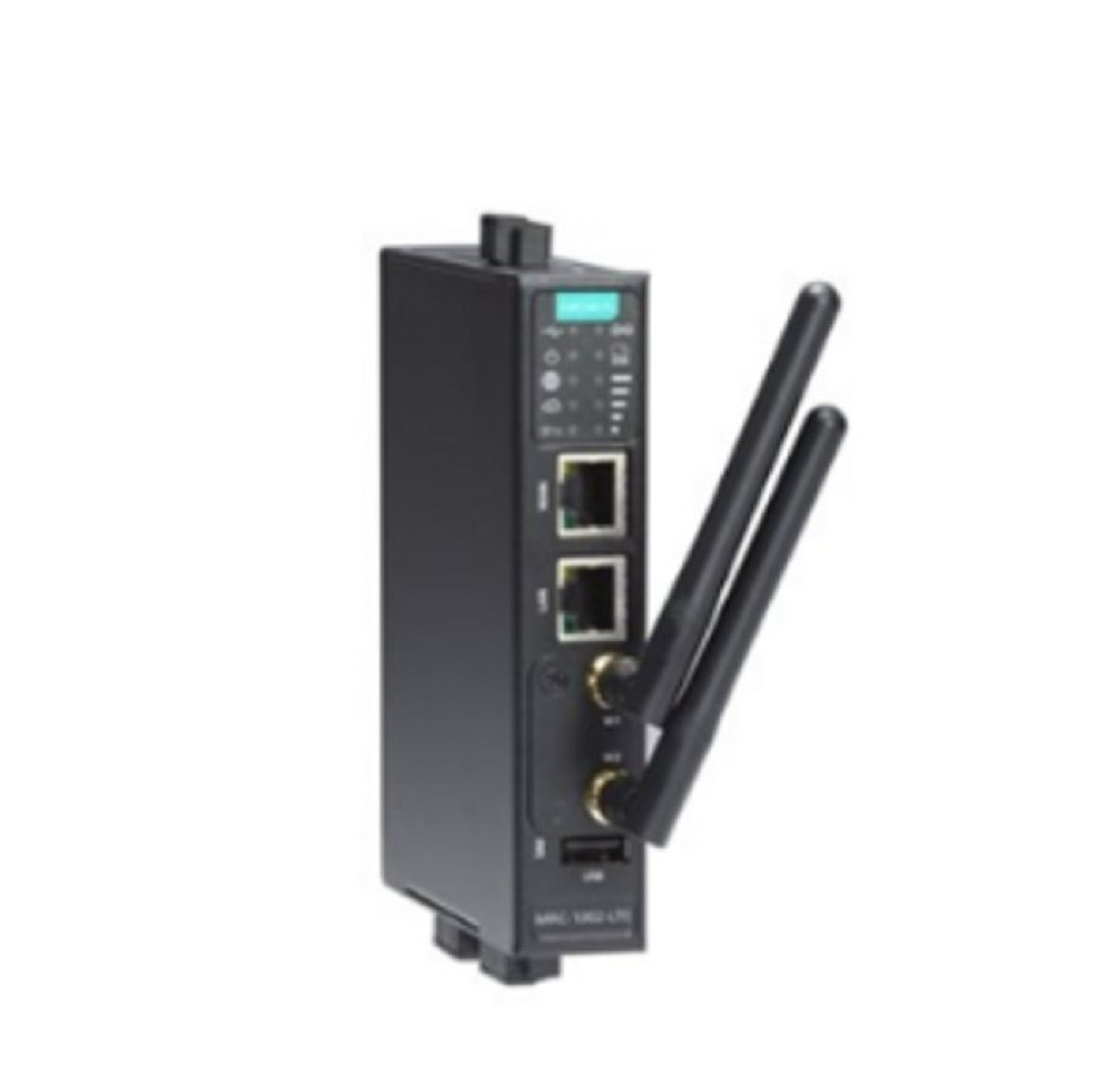
MOXA AIG-301-AZU-LX
AIG-301 Series- Contact Us for Availability or Possible Alternatives
| Exclusive Bulk Pricing on Select Products | ||
| Sign Up to Access. |
Features and Benefits
- Supports generic MQTT client
- Supports MQTT connection with built-in device SDKs for Azure/AWS cloud
- Supports Modbus RTU/ASCII/TCP master/client
- Supports Modbus TCP server
- Supports Azure IoT Edge
- Supports data buffering using store and forward and datalogger
- Supports easy device-provisioning with the ThingsPro Proxy utility
- Provides robust OTA function to prevent system failure during software upgrades
- Equipped with Secure Boot to prevent malicious software-injection attacks
- -40 to 70°C operating temperature range
- LTE Cat. 4 US, EU, and APAC models available
Introduction
The AIG-301 Series advanced IIoT gateways are designedfor Industrial IoT applications, especially for distributed and unmannedsites in harsh operating environments. The gateways implement ModbusRTU/TCP master/client protocols which can help you to effortlesslycollect data from Modbus devices. Moreover, Azure IoT Edge softwareis preloaded and seamlessly integrated with the AIG-301 to enableeasy, reliable, yet secure sensor-to-cloud connectivity for data acquisitionand device management using the Azure Cloud solution. With the useof the ThingsPro Proxy utility, the device provisioning process iseasier than ever. Thanks to the robust OTA function, you never haveto worry about system failure during software upgrades. With the SecureBoot function enabled, you can prevent malicious software injectionattacks, especially during the boot-up process.
Appearance
AIG-301-T-AZU-LX
AIG-301US, EU, AP, and CN Models










__57223.1754455245.jpg?c=1 80w, https://cdn11.bigcommerce.com/s-exhcjslbho/images/stencil/160w/products/8867/30694/moxa-aig-301-series-image-(1)__57223.1754455245.jpg?c=1 160w, https://cdn11.bigcommerce.com/s-exhcjslbho/images/stencil/320w/products/8867/30694/moxa-aig-301-series-image-(1)__57223.1754455245.jpg?c=1 320w, https://cdn11.bigcommerce.com/s-exhcjslbho/images/stencil/640w/products/8867/30694/moxa-aig-301-series-image-(1)__57223.1754455245.jpg?c=1 640w, https://cdn11.bigcommerce.com/s-exhcjslbho/images/stencil/960w/products/8867/30694/moxa-aig-301-series-image-(1)__57223.1754455245.jpg?c=1 960w, https://cdn11.bigcommerce.com/s-exhcjslbho/images/stencil/1280w/products/8867/30694/moxa-aig-301-series-image-(1)__57223.1754455245.jpg?c=1 1280w, https://cdn11.bigcommerce.com/s-exhcjslbho/images/stencil/1920w/products/8867/30694/moxa-aig-301-series-image-(1)__57223.1754455245.jpg?c=1 1920w, https://cdn11.bigcommerce.com/s-exhcjslbho/images/stencil/2560w/products/8867/30694/moxa-aig-301-series-image-(1)__57223.1754455245.jpg?c=1 2560w)
__53482.1754455245.jpg?c=1 80w, https://cdn11.bigcommerce.com/s-exhcjslbho/images/stencil/160w/products/8867/30695/moxa-aig-301-series-image-1-(1)__53482.1754455245.jpg?c=1 160w, https://cdn11.bigcommerce.com/s-exhcjslbho/images/stencil/320w/products/8867/30695/moxa-aig-301-series-image-1-(1)__53482.1754455245.jpg?c=1 320w, https://cdn11.bigcommerce.com/s-exhcjslbho/images/stencil/640w/products/8867/30695/moxa-aig-301-series-image-1-(1)__53482.1754455245.jpg?c=1 640w, https://cdn11.bigcommerce.com/s-exhcjslbho/images/stencil/960w/products/8867/30695/moxa-aig-301-series-image-1-(1)__53482.1754455245.jpg?c=1 960w, https://cdn11.bigcommerce.com/s-exhcjslbho/images/stencil/1280w/products/8867/30695/moxa-aig-301-series-image-1-(1)__53482.1754455245.jpg?c=1 1280w, https://cdn11.bigcommerce.com/s-exhcjslbho/images/stencil/1920w/products/8867/30695/moxa-aig-301-series-image-1-(1)__53482.1754455245.jpg?c=1 1920w, https://cdn11.bigcommerce.com/s-exhcjslbho/images/stencil/2560w/products/8867/30695/moxa-aig-301-series-image-1-(1)__53482.1754455245.jpg?c=1 2560w)
__35160.1754455245.jpg?c=1 80w, https://cdn11.bigcommerce.com/s-exhcjslbho/images/stencil/160w/products/8867/30696/moxa-aig-301-series-image-2-(1)__35160.1754455245.jpg?c=1 160w, https://cdn11.bigcommerce.com/s-exhcjslbho/images/stencil/320w/products/8867/30696/moxa-aig-301-series-image-2-(1)__35160.1754455245.jpg?c=1 320w, https://cdn11.bigcommerce.com/s-exhcjslbho/images/stencil/640w/products/8867/30696/moxa-aig-301-series-image-2-(1)__35160.1754455245.jpg?c=1 640w, https://cdn11.bigcommerce.com/s-exhcjslbho/images/stencil/960w/products/8867/30696/moxa-aig-301-series-image-2-(1)__35160.1754455245.jpg?c=1 960w, https://cdn11.bigcommerce.com/s-exhcjslbho/images/stencil/1280w/products/8867/30696/moxa-aig-301-series-image-2-(1)__35160.1754455245.jpg?c=1 1280w, https://cdn11.bigcommerce.com/s-exhcjslbho/images/stencil/1920w/products/8867/30696/moxa-aig-301-series-image-2-(1)__35160.1754455245.jpg?c=1 1920w, https://cdn11.bigcommerce.com/s-exhcjslbho/images/stencil/2560w/products/8867/30696/moxa-aig-301-series-image-2-(1)__35160.1754455245.jpg?c=1 2560w)
__70191.1754455245.jpg?c=1 80w, https://cdn11.bigcommerce.com/s-exhcjslbho/images/stencil/160w/products/8867/30697/moxa-aig-301-series-image-3-(1)__70191.1754455245.jpg?c=1 160w, https://cdn11.bigcommerce.com/s-exhcjslbho/images/stencil/320w/products/8867/30697/moxa-aig-301-series-image-3-(1)__70191.1754455245.jpg?c=1 320w, https://cdn11.bigcommerce.com/s-exhcjslbho/images/stencil/640w/products/8867/30697/moxa-aig-301-series-image-3-(1)__70191.1754455245.jpg?c=1 640w, https://cdn11.bigcommerce.com/s-exhcjslbho/images/stencil/960w/products/8867/30697/moxa-aig-301-series-image-3-(1)__70191.1754455245.jpg?c=1 960w, https://cdn11.bigcommerce.com/s-exhcjslbho/images/stencil/1280w/products/8867/30697/moxa-aig-301-series-image-3-(1)__70191.1754455245.jpg?c=1 1280w, https://cdn11.bigcommerce.com/s-exhcjslbho/images/stencil/1920w/products/8867/30697/moxa-aig-301-series-image-3-(1)__70191.1754455245.jpg?c=1 1920w, https://cdn11.bigcommerce.com/s-exhcjslbho/images/stencil/2560w/products/8867/30697/moxa-aig-301-series-image-3-(1)__70191.1754455245.jpg?c=1 2560w)
__42596.1754455246.jpg?c=1 80w, https://cdn11.bigcommerce.com/s-exhcjslbho/images/stencil/160w/products/8867/30698/moxa-aig-301-series-image-4-(1)__42596.1754455246.jpg?c=1 160w, https://cdn11.bigcommerce.com/s-exhcjslbho/images/stencil/320w/products/8867/30698/moxa-aig-301-series-image-4-(1)__42596.1754455246.jpg?c=1 320w, https://cdn11.bigcommerce.com/s-exhcjslbho/images/stencil/640w/products/8867/30698/moxa-aig-301-series-image-4-(1)__42596.1754455246.jpg?c=1 640w, https://cdn11.bigcommerce.com/s-exhcjslbho/images/stencil/960w/products/8867/30698/moxa-aig-301-series-image-4-(1)__42596.1754455246.jpg?c=1 960w, https://cdn11.bigcommerce.com/s-exhcjslbho/images/stencil/1280w/products/8867/30698/moxa-aig-301-series-image-4-(1)__42596.1754455246.jpg?c=1 1280w, https://cdn11.bigcommerce.com/s-exhcjslbho/images/stencil/1920w/products/8867/30698/moxa-aig-301-series-image-4-(1)__42596.1754455246.jpg?c=1 1920w, https://cdn11.bigcommerce.com/s-exhcjslbho/images/stencil/2560w/products/8867/30698/moxa-aig-301-series-image-4-(1)__42596.1754455246.jpg?c=1 2560w)
__77179.1754455246.jpg?c=1 80w, https://cdn11.bigcommerce.com/s-exhcjslbho/images/stencil/160w/products/8867/30699/moxa-aig-301-series-image-5-(1)__77179.1754455246.jpg?c=1 160w, https://cdn11.bigcommerce.com/s-exhcjslbho/images/stencil/320w/products/8867/30699/moxa-aig-301-series-image-5-(1)__77179.1754455246.jpg?c=1 320w, https://cdn11.bigcommerce.com/s-exhcjslbho/images/stencil/640w/products/8867/30699/moxa-aig-301-series-image-5-(1)__77179.1754455246.jpg?c=1 640w, https://cdn11.bigcommerce.com/s-exhcjslbho/images/stencil/960w/products/8867/30699/moxa-aig-301-series-image-5-(1)__77179.1754455246.jpg?c=1 960w, https://cdn11.bigcommerce.com/s-exhcjslbho/images/stencil/1280w/products/8867/30699/moxa-aig-301-series-image-5-(1)__77179.1754455246.jpg?c=1 1280w, https://cdn11.bigcommerce.com/s-exhcjslbho/images/stencil/1920w/products/8867/30699/moxa-aig-301-series-image-5-(1)__77179.1754455246.jpg?c=1 1920w, https://cdn11.bigcommerce.com/s-exhcjslbho/images/stencil/2560w/products/8867/30699/moxa-aig-301-series-image-5-(1)__77179.1754455246.jpg?c=1 2560w)
__67738.1754455246.jpg?c=1 80w, https://cdn11.bigcommerce.com/s-exhcjslbho/images/stencil/160w/products/8867/30700/moxa-aig-301-series-image-6-(1)__67738.1754455246.jpg?c=1 160w, https://cdn11.bigcommerce.com/s-exhcjslbho/images/stencil/320w/products/8867/30700/moxa-aig-301-series-image-6-(1)__67738.1754455246.jpg?c=1 320w, https://cdn11.bigcommerce.com/s-exhcjslbho/images/stencil/640w/products/8867/30700/moxa-aig-301-series-image-6-(1)__67738.1754455246.jpg?c=1 640w, https://cdn11.bigcommerce.com/s-exhcjslbho/images/stencil/960w/products/8867/30700/moxa-aig-301-series-image-6-(1)__67738.1754455246.jpg?c=1 960w, https://cdn11.bigcommerce.com/s-exhcjslbho/images/stencil/1280w/products/8867/30700/moxa-aig-301-series-image-6-(1)__67738.1754455246.jpg?c=1 1280w, https://cdn11.bigcommerce.com/s-exhcjslbho/images/stencil/1920w/products/8867/30700/moxa-aig-301-series-image-6-(1)__67738.1754455246.jpg?c=1 1920w, https://cdn11.bigcommerce.com/s-exhcjslbho/images/stencil/2560w/products/8867/30700/moxa-aig-301-series-image-6-(1)__67738.1754455246.jpg?c=1 2560w)




